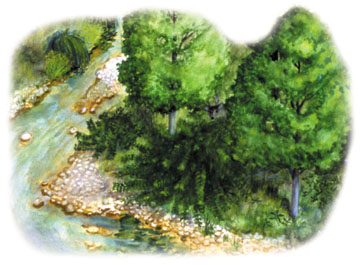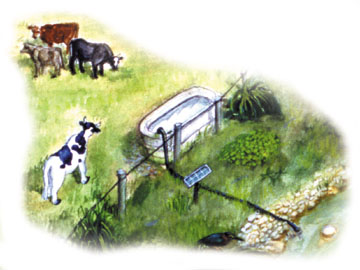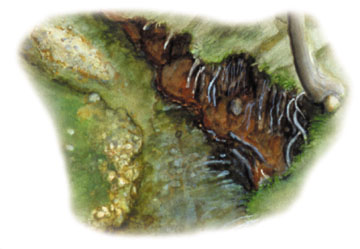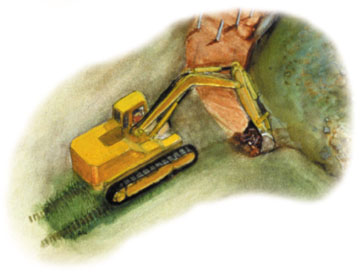|
A Landowner's Guide to
|
| Tennessee's streams are one of our state's most beautiful assets. They give us drinking water and irrigate our crops. They are home to a tremendous diversity of wildlife and provide us with great fishing spots! Before working in streams, it is important to understand why streams behave the way they do, the best methods for keeping them from damaging and eroding surrounding land, and what regulations are in place to keep streams healthy. This is a guide to streambank protection and stabilization. |
How does channelization affect a stream? 
Channelization straightens, deepens and can widen a stream. Water flows much faster through the altered channel, resulting in increased erosion and flooding downstream. The straightened channel also moves more gravel and sediment downstream. In addition, channelizing can strip streambanks of vegetation, making them more prone to erosion.
Good anglers know that the best fishing is in deep holes or pools. Pools help protect streambanks from erosion by absorbing some of the energy of the flowing water. By removing pools, riffles and deep holes, channelizing can harm fish and other aquatic life in the stream.
Although channelization may appear to solve a problem in the short term, the stream will constantly work to return to its natural shape. This short-term solution can result in long-term problems and high, recurring costs.
 Why do I need a permit from the
state to work in my stream?
Why do I need a permit from the
state to work in my stream?
The streams and rivers of Tennessee cross many property lines. Many Tennesseans rely on our streams, rivers, and lakes for drinking water. Streams and rivers are also home to countless plants and animals. By law, the Tennessee Department of Environment and Conservation is required to protect this critical resource. To do so, TDEC has designed a permit program that provides landowners with guidelines for stabilizing streambanks and removing logs and other woody debris from the stream channel. By maintaining streams and solving small problems before they worsen, landowners protect their land from more serious damage in the future.
How can I tell if the water flowing on my property is regulated by the state?
If a channel carries water for longer than a week after the last rain, it is likely classified as a stream, and working in it may require the use of state guidelines or a state permit. Digging or grading within stream channels with heavy equipment usually requires a permit. You won't need a permit if you're removing logs and other woody vegetation by cutting or dragging, even with heavy equipment.
Can I clean trees and brush out of a stream channel?
Yes. Permits are not needed to pull downed trees out of streams or to remove live trees and brush. However, you may need a permit if you want to dig out stumps and roots. Please keep in mind that unless trees are leaning and about to fall into the creek, they should be left alone. Streamside trees hold the streambank in place, provide valuable habitat for fish and other species, and keep the stream cool.
Can I make changes to the channel so that the creek won't flood?
When it rains, streams often flood. This natural process can be managed, but not prevented. Even expensive, tax-funded projects usually do not eliminate flooding. The best way to manage flooding is to keep your stream channel free of downed trees and other woody debris and to keep culverts open. Also, avoid placing buildings next to streams, as they could be damaged by flooding.
Can I move the stream channel?
Sometimes. Generally, the state will issue you an individual permit to move a stream if, in your permit application, you suggest an effective way to stabilize the re-established channel. Permits are usually issued if you request a minor channel relocation as part of a stream bank stabilization project. Effective stabilization usually involves bioengineering or hard-armoring with riprap.
Can I remove gravel from the channel?
Yes, this activity can normally be authorized when state guidelines are followed. Gravel can be removed for personal use from gravel bars that do not support well-established trees and vegetation. This work must be done žin the dry,Ó with a berm separating the work area from the flowing water. No approval is required to remove small amounts of gravel with hand tools.
Can I use gravel, sand or cobble from the stream channel to fix eroding stream banks?
 No. Loose gravel or cobble cannot be used to stabilize
large sections of banks unless it is stabilized in some way.
No. Loose gravel or cobble cannot be used to stabilize
large sections of banks unless it is stabilized in some way.
Experience shows that, in the long run, pushing the gravel, sand and cobble from stream channels against eroding banks will not work unless banks are stabilized with living trees, rip-rap or some other permanent solution. In most cases, the pushed-up material washes away during the next big storm, causing more erosion in the area you were trying to fix and more problems downstream. If you want to fix eroding streambanks, consider a bioengineering project using natural materials, such as anchored trees, rootwads, large rocks, or live trees such as willows.
A common belief is that gravel bars cause erosion by pushing the water to the other side of the channel and that using a bulldozer to move the gravel will solve the problem. This approach ultimately causes more problems downstream. Although gravel bars may look like they are part of the problem, they are actually helping the stream function in a healthy way. They slow the water, which reduces erosion.
Frequently Asked Questions || Stabilizing Streambanks || Keeping Streams Healthy || Permits

